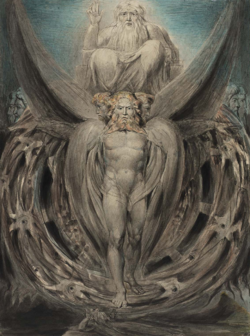Jenol
| Jenol | |||||
|---|---|---|---|---|---|
| Astralgenitor of Genagel; the Guldron | |||||
 | |||||
| Pre-Stargalonian Patriarch | |||||
| Born |
3360 JH Qoj Anoqod | ||||
| Ascension into Heaven |
3400 JH Plateau of the Throne | ||||
| Consort | Gogasi | ||||
| Issue | Namiqulyah, Roiswula | ||||
| |||||
| Jenolite Heavener | |||||
| Other names | Genagel, Guldron | ||||
| Venerated in | Ancient Jenolite religion, Qoren Nolianism, Bargorishianism | ||||
| Plane | Wunandic | ||||
| Symbols | Tricephalic animals | ||||
| Number |
ᎧᎦᏂ[Ꮣ]: "Ba-yus-cro Tans" "Five-Score, three less" | ||||
Jenol is a Zoragric figure and pre-Stargalonian patriarch in Jenolite mythology, considered the progenitor and namesake of the Jenolites, and the grandfather of the key matriarch Mothúdul through his first son Namiqulyah, and Goul the Exiler through his second son Roiswula. He is said to have been born on the mound Qoj Anoqod 3360 years after the birth of humanity, which is traditionally dated in most Nolian schools to 98,440 AA by the Tusoloti chronology, or as early as 1500–1750 AA according to most Derasant sects. He is venerated in Qoren Nolianism as a primary component of heaven via the Wunandic plane, while in Bargorishianism and other traditions he is considered a contributory attribute to one of the principal three deities, Guldron.
Although the namesake of the later Jenolite tradition, the character of Jenol features only faintly in the narrative of the canonical texts of the Zoragra, although he appears frequently in metaphor and epithets. In the Book of Levitations, which contains the most information regarding the patriarch in the Zoragric arch-teachings, Jenol is mentioned in several passing allusions within the context of his granddaughter. He is said to have "elected great letters" upon his granddaughter, which served as a foundation for her later immense knowledge. Jenol also is said to have perfected the art of astral concentration to "walk with Heaveners", before ascending from the Plateau of the Throne on his fortieth birthday. Traditionally this was thought to mean he was one of the Twenty Beholders as mentioned in the Book of Gúlijalah, or beings who have seen/will see Jana'ah and live. This is alluded to in the Book of the Elect, which asserts that Jenol foresaw the end of humanity, but interceded on behalf of them upon his ascension. In later traditions Jenol was established as the corporeal origin for the archwalker Genagel, most predominately in the Mialoqanic Book of Tabulations. The prophet Gúlijalah similarly mentions Jenol in two parables, found in Gúlijalah 11 and 40, the latter of which quoting directly from Tabulations 20:4. This text establishes that Jenol projected his spirit into the three-headed avatar of Genagel, one of the five archwalkers who each patrol a corner of the region of Stargalon. As such Jenol-Genagel is commonly associated with the Daric direction. Jenol is also thought to have been one component of the being Guldron, revered in Qoren Nolianism as the armor of Jana'úh Qurgil ("Jana who then purifies the human plane"), an aspect of the deity pertinent to the formal end of humanity.
In other traditions, such as Bargorishianism, Guldron is part of a tri-theistic pantheon, making him coequal to Jana and Qíva. Considered the manifestation of the phenomenon of time, Guldron is formed from five vessels from each of the Five Ages. The five aspects are separately the deities Laqa, Talma, Qrisha, Moma, and Rana, who come together to form Guldron at the passage of the new year and at the Last Breath of Humanity. Through the three-headed avatar Genagel, Jenol is thought to watch the past, present, and future on behalf of this quinquevirate, or is alternatively consubstantial with Qrisha, watcher of the current age. Genagel is traditionally depicted with three heads for each of the three aspects of time, and is cloaked in innumerable eyes. Genagel is also traditionally seen as the "Quos of Walkers" because of this association, with the archwalkers Damugel, Palagel, Runungel, and Qagegal considered his supporters rather than his compeers as in Qoren Nolianism.